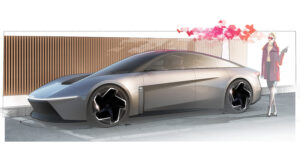Reviving Chrysler, Jeep, Dodge, and RAM: The Case for Bold Innovation and Strategic Realignment

Chrysler Halcyon Concept design sketch.

The recent resignation of Carlos Tavares as Stellantis CEO, coupled with growing dissatisfaction among U.S. Chrysler, Jeep, Dodge, and RAM dealers, has highlighted deep-rooted issues within Stellantis. The company’s U.S. brands have struggled to keep pace with evolving market demands, relying heavily on aging platforms and superficial facelifts instead of meaningful innovation. While Tavares was instrumental in cost-cutting and facilitating the PSA-FCA merger, his departure offers an opportunity to rethink long-term strategies for Stellantis’ American brands.

The Problem: Stagnation in Design and Technology
At the core of the issue is Stellantis’ reliance on outdated architectures and design philosophies:
- Aging Platforms:
Many Chrysler, Jeep, Dodge, and RAM products are built on architectures that are years, if not decades, old. This limits their ability to compete with rivals that offer modern platforms with superior efficiency, safety, and performance. - Facelifts Over Redesigns:
Cosmetic updates have served as a stopgap measure, but they fail to address fundamental design and engineering shortcomings. Consumers increasingly demand more than just a new grille or updated headlights—they expect innovation. - Dealer Discontent:
Dealers are grappling with bloated inventories and insufficient marketing support. This reflects a lack of alignment between Stellantis’ production output and actual market demand. - Brand Fragmentation:
The distinct identities of Chrysler, Jeep, Dodge, and RAM are becoming muddled. For instance, Chrysler, once synonymous with innovation, now offers a sparse lineup that lacks direction.

The Solution: A Vision for Long-Term Renewal
To resolve these issues, Stellantis must prioritize a fundamental overhaul rather than incremental fixes. Here’s how:
1. Invest in Modern Architectures
- Scalable Platforms: Develop new platforms that can underpin a variety of vehicles across multiple segments and brands. These platforms should prioritize electrification, connectivity, and modularity.
- Hybrid and EV Integration: Stellantis must take the lead in the transition to electric mobility, particularly for Jeep and RAM, whose rugged brand identities can leverage EV technology for better performance and environmental sustainability.
2. Reinvigorate Design Philosophy
- Distinct Identities: Reestablish clear, aspirational identities for each brand:
- Chrysler: Premium innovation, targeting competitors like Tesla and Cadillac.
- Jeep: Rugged adventure with cutting-edge off-road tech and electrification.
- Dodge: High-performance, muscle-inspired EVs for a modern audience.
- RAM: Durable and innovative workhorse trucks with advanced towing tech and electrification.
- Consumer-Centric Designs: Incorporate customer feedback and market research to create vehicles that resonate with evolving consumer preferences.
3. Strengthen Dealer Relationships
- Incentives and Inventory Management: Collaborate with dealers to align production schedules with real-world demand.
- Transparency and Support: Implement regular communication channels to address dealer concerns and foster trust.
4. Embrace Technology Partnerships
- Partner with tech companies to leapfrog competitors in autonomous driving, AI-based vehicle interfaces, and in-car connectivity.
- Build strategic alliances to share the cost and expertise required for next-generation propulsion systems.
5. Launch a Bold Marketing Campaign
- Unified Vision: Highlight Stellantis’ commitment to innovation across all brands, showcasing a cohesive vision for the future.
- Dealer-Centric Programs: Provide dealers with resources to effectively market the updated products, including local campaigns tailored to specific markets.
The Path Forward
Stellantis has a unique opportunity to redefine its legacy brands for the modern era. While cost-cutting measures helped stabilize the company post-merger, they are not a sustainable strategy. By investing in innovation, realigning with dealer expectations, and delivering products that excite consumers, Stellantis can reclaim its position as a leader in the U.S. automotive market.
The next CEO must recognize that the future of Stellantis hinges not on maintaining the status quo, but on bold decisions that prioritize long-term growth over short-term savings. The stakes are high, but the potential rewards—for the company, its dealers, and its customers—are even higher.






